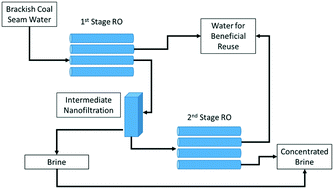Enhanced water recovery in the coal seam gas industry using a dual reverse osmosis system
Abstract
Mining of brines produced in the coal seam gas industry for water and salts is of major concern globally. This study focussed on the use of a dual stage reverse osmosis system to achieve high water recovery rates. It was our hypothesis that an intermediate nanofiltration stage was required to stabilize the performance of the second reverse osmosis stage. The second stage RO membrane was found to be fouled by silica and aluminosilicates when used with any intermediate brine treatment. Theoretical predictions using PHREEQC software supported the experimental outcomes in terms of identifying species with high scaling potential. Coagulation of the coal seam brine using aluminium chlorohydrate was found to remove up to 70.5% of dissolved silica and thus this method may be useful for prevention of fouling of downstream membranes. ROSA software was also employed to enable selection of possible nanofiltration membranes to treat the coal seam brine sample. Tighter membranes were found to exhibit significantly higher rejection of ions responsible for scale formation during brine concentration operations. Albeit, the flux rates were less than the looser membrane types. A pressure of 20 bar was suggested to be practical for the nanofiltration stage as the flux rate more than doubled from the flux estimated at 15 bar. An intermediate nanofiltration stage perhaps combined with a coagulation step is recommended for use in a dual stage RO system to concentrate coal seam brines.

- This article is part of the themed collection: Brine Mining Nexus


 Please wait while we load your content...
Please wait while we load your content...